Archive for the ‘The Sunday Times – Articles’ Category
-
AND THEY ALL CAME TO SEA
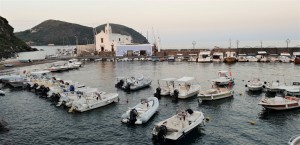 At the centre of the attractive small harbour of Marina Corta in Lipari, there is an unassuming quaint church dedicated to Our Lady of the Snow and to the Souls of Purgatory. One could easily fail to visit this place since fun and life beckons from the several restaurants, cafeterias and shops situated right across in the spacious square. Yet a most unique and pleasant surprise awaits those who decide to step inside.
At the centre of the attractive small harbour of Marina Corta in Lipari, there is an unassuming quaint church dedicated to Our Lady of the Snow and to the Souls of Purgatory. One could easily fail to visit this place since fun and life beckons from the several restaurants, cafeterias and shops situated right across in the spacious square. Yet a most unique and pleasant surprise awaits those who decide to step inside.The church was built in 1545, just five years after the island of Lipari was sacked by the Turkish corsair Barbarossa who took away almost the entire population into slavery. Defiantly constructed on the jutting rocks, the church intended to serve as a point of reference for those who repopulated the island.
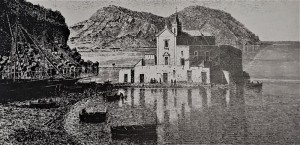 However, along the years, as other chapels and churches were built around Lipari, this church was abandoned and left to its own destiny. Critically close to the sea, the building suffered severe damage, and in recent years, it was on the brink of collapse.
However, along the years, as other chapels and churches were built around Lipari, this church was abandoned and left to its own destiny. Critically close to the sea, the building suffered severe damage, and in recent years, it was on the brink of collapse.On a cold winter day in 2011, with the rough seas hitting mercilessly at this church, a group of locals decided to save this place. They were all saddened by the neglected state of this historical building and they were adamant to do something about it. After they came out with a plan, they discussed their ideas with their parish priest, Fr Giuseppe Mirabito, who agreed at once to collaborate with them.
The Association SS. Cosma and Damiano Marinacorta was established to coordinate this project. The stability of the building was the first thing which had to be addressed quickly. As the members of the association talked about this project with other locals and friends, support came in the form of the required materials and voluntary help. In time, the external part of the church was restored. However, the internal area of the church remained in dire need of restoration.
 As the building started to regain its dignity, the association’s members needed to come up with new ideas to attract visitors to the church. Their main aim was to create more awareness about the historical and cultural value of this building so that more people would help out with this venture, particularly with the funds which were required to restore the church completely.
As the building started to regain its dignity, the association’s members needed to come up with new ideas to attract visitors to the church. Their main aim was to create more awareness about the historical and cultural value of this building so that more people would help out with this venture, particularly with the funds which were required to restore the church completely.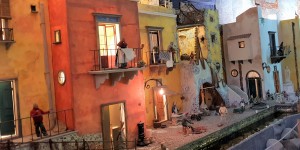 Since it was close to Christmas, they decided to build a crib inside the church. But this was no ordinary crib with religious iconography. Instead, it was laid out to represent the fishing village of Lipari as it was in the old days and it was named Presepe del Mare.
Since it was close to Christmas, they decided to build a crib inside the church. But this was no ordinary crib with religious iconography. Instead, it was laid out to represent the fishing village of Lipari as it was in the old days and it was named Presepe del Mare.Peppuccio Costanzo, one of the association’s members and a fisherman, assisted in the design of this crib which was made of papier-mache. The miniature village was a replica of the real buildings, architecture and life that existed in Lipari around fifty years ago. A number of known village characters were also included in this most unusual crib.
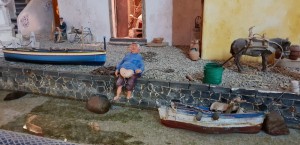 The crib’s landscape was built along a watercourse with real fish living inside. The crib is mostly populated by fishermen, some of whom are at work while others are idling around. The attention which was given to the details in this crib acts as a time capsule to help visitors visualize better how Lipari looked before it was regenerated to suit the needs of the increasing tourist demands. It also pictures several traditions of the time. Locals may even recognize some of the people represented in the figurines; a number of whom have by now passed away.
The crib’s landscape was built along a watercourse with real fish living inside. The crib is mostly populated by fishermen, some of whom are at work while others are idling around. The attention which was given to the details in this crib acts as a time capsule to help visitors visualize better how Lipari looked before it was regenerated to suit the needs of the increasing tourist demands. It also pictures several traditions of the time. Locals may even recognize some of the people represented in the figurines; a number of whom have by now passed away.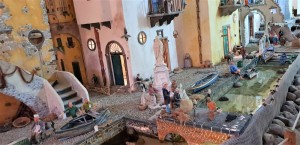 Existing landmarks such as the church of St Joseph and the statue of St Bartholomew serve as identifying marks in the changing village. Gone are most of the old houses which can be seen in the crib. Today, these have been replaced by higher modern buildings. Traditional life as shown in the crib has almost dissolved into nothingness. Tradesmen’s shops have been taken over by modern outlets selling souvenirs or boat rides. The fish seller who called out in the streets, nowadays displays his fish in a van. Women do not carry water jugs anymore; tap water is now readily available. Clothes are no longer washed in public places; washing machines take care of this matter. The young man who played the guitar beneath the balcony of the girl he loved will today send her an sms instead.
Existing landmarks such as the church of St Joseph and the statue of St Bartholomew serve as identifying marks in the changing village. Gone are most of the old houses which can be seen in the crib. Today, these have been replaced by higher modern buildings. Traditional life as shown in the crib has almost dissolved into nothingness. Tradesmen’s shops have been taken over by modern outlets selling souvenirs or boat rides. The fish seller who called out in the streets, nowadays displays his fish in a van. Women do not carry water jugs anymore; tap water is now readily available. Clothes are no longer washed in public places; washing machines take care of this matter. The young man who played the guitar beneath the balcony of the girl he loved will today send her an sms instead.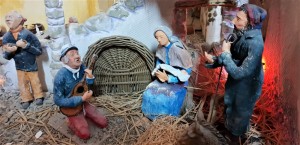 The crib’s culmination and originality is certainly in the warm and simple nativity scene where fishermen are greeting baby Jesus, not sheperds. Colourful fishing boats and straw fishermen’s baskets are present in the area, not hills and sheep. An angel sings besides a balcony of a house not on top of a cave.
The crib’s culmination and originality is certainly in the warm and simple nativity scene where fishermen are greeting baby Jesus, not sheperds. Colourful fishing boats and straw fishermen’s baskets are present in the area, not hills and sheep. An angel sings besides a balcony of a house not on top of a cave.As people came to visit this crib, it became evident that this was more than a seasonal project. Soon it was decided that this crib should remain in this church as a cultural symbol of Lipari. The crib would be visitable all around the year and whoever paid the entrance fee of €1 would be assisting in the restoration of the church.
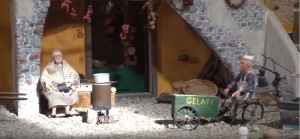 By now, Presepe del Mare has come to form part of the cultural identity of Lipari. Besides presenting the craftsmanship of those who made it, the crib is also a relevant reminder of the importance of keeping traditions alive and of conserving the remaining architecture of the area.
By now, Presepe del Mare has come to form part of the cultural identity of Lipari. Besides presenting the craftsmanship of those who made it, the crib is also a relevant reminder of the importance of keeping traditions alive and of conserving the remaining architecture of the area.Info about Lipari: The island of Lipari is the largest of the Aeolian volcanic archipelago. Nowadays, its population is around 12,700, although it generally reaches 20,000 during the tourist season, from May to September. Due to its charming character, historical value and holiday atmosphere, Lipari is a top destination. Fast ferry connections from Sicily all stop at this island, as well as plenty of boats and hydrofoils, making it the ideal place to reach the other islands in the archipelago – Vulcano, Salina, Stromboli, Filicudi, Alicudi, Panarea and Basiluzzo.
(This feature was published in The Christmas Supplement issued with The Sunday Times of Malta on 2nd December 2018)
-
Long shell life
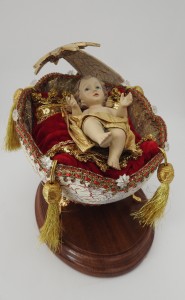 Although during the Christmas season, it is customary to see statues of baby Jesus in a manger or in a crib, in Candice Fava’s shop New EGGsperience, the holy child would be seen resting in a decorated eggshell.
Although during the Christmas season, it is customary to see statues of baby Jesus in a manger or in a crib, in Candice Fava’s shop New EGGsperience, the holy child would be seen resting in a decorated eggshell.“I love to create unique hand-made objects and this craft of eggshell decoration has provided me with the opportunity to have my own niche market,” Fava explains.
Fava was raised on a farm in Australia, where her family sold eggs. They had several clients but one particular client intrigued Fava since she regularly purchased a substantial quantity of eggs.
“One day I decided to ask her why she always needed so many eggs and she promised that the next time she called at our farm, she would bring me a gift to show me. I felt deeply curious and I awaited her next visit with much anticipation. Eventually, she brought me a little jewel box adorned with lovely fabrics and accessories. I could not believe that she had actually made it with one of the eggs from our farm!”
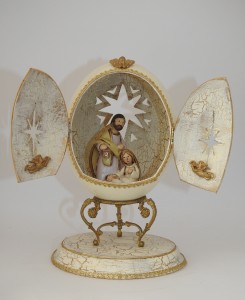 Fava was so fascinated with this idea that she decided to learn this craft. At the farm, she had all the eggs that she required and in time she learnt how to clean them without breaking them. Soon, she was producing her own eggshell decorations.
Fava was so fascinated with this idea that she decided to learn this craft. At the farm, she had all the eggs that she required and in time she learnt how to clean them without breaking them. Soon, she was producing her own eggshell decorations.“The first item I made was a jewel box which I painted with bright nail polish. I was so delighted when I saw it ready! Today I realize that it wasn’t much but it is still very dear to me as it reminds me from where it all started.”
Along the years, eggshell decoration became an integral part of Fava’s life. Which explains why she was surprised when she came over to Malta and realized that this craft was totally unknown on the island.
“It was hard at first to find the necessary materials to work with. However, my husband Ivan helped me to locate some local farms which could provide me with eggs. He also assisted me in the cleaning and sterilization of the eggshells.”
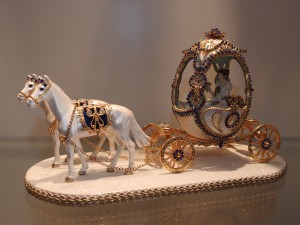 Initially she decorated eggshells for her personal enjoyment. Then she began to give them out as gifts to her friends.
Initially she decorated eggshells for her personal enjoyment. Then she began to give them out as gifts to her friends.“My friends were delighted with these eggshell decorations since they had never seen anything like them before. Soon they were asking me to make some more creations for them so that they could give them as presents to others. It was only a matter of time until I confirmed that there was a demand for such products.”
Ultimately, people’s positive reactions to her craft led her to open her own shop in Zabbar.
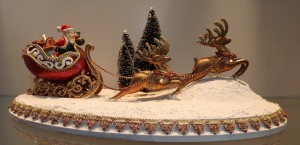 “By then, I had produced so many various eggshell decorations that I had no difficulty to fill the shop with my creations. Each time that new clients come in, it is charming to see their incredulity that so many exquisite things can be made from common fragile eggshells.”
“By then, I had produced so many various eggshell decorations that I had no difficulty to fill the shop with my creations. Each time that new clients come in, it is charming to see their incredulity that so many exquisite things can be made from common fragile eggshells.”Nowadays, the Favas have located foreign suppliers who are able to furnish them with quantities of ready-made cleaned and sterilized eggshells. Moreover, they have also managed to establish contacts with suppliers of other materials with which the eggshells are decorated.
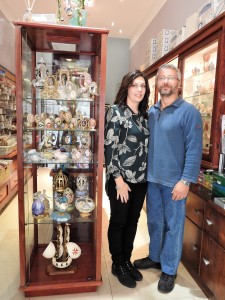 “My husband supports me a lot and helps me to come out with new ideas. Along the years, he too became enthusiastic about this work and now he is able to make his own creations.”
“My husband supports me a lot and helps me to come out with new ideas. Along the years, he too became enthusiastic about this work and now he is able to make his own creations.”A wide range of differently decorated eggshells which are ideal as gifts for various occasions are displayed at their shop. However, a few of them are not for sale.
“When we join forces, we create the best decorations,” the two agree. “The collaboration of ideas lead to exclusive objects which become difficult to part from. Some of them, such as the lamp shade, the handbag set and the sea vessel, are cherished objects and we have won prestigious awards for them at local national craft competitions. Such works provide us also with the opportunity to combine different materials and crafts like woodwork and eggshell decoration. Our imagination has no limit, however we are restrained with the eggshells’ curvatures, although we take that as part of the challenge.”
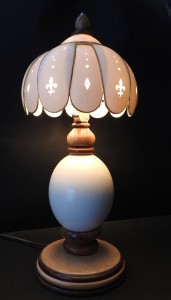 Even though all of the creations may serve as decorations, some of them also have their own practical use, acting as exotic containers, wearable accessories or light fittings.
Even though all of the creations may serve as decorations, some of them also have their own practical use, acting as exotic containers, wearable accessories or light fittings.“Besides selling our creations from my shop, I also participate in several fairs and exhibitions and therefore more people are getting to know about this craft. Presently I am also taking part in the program Niskata which airs on TVM. Yet there is still much more to do to create more awareness.”
“It is great to see how far a simple hobby can take you. Little by little, all my family has become involved in this craft. In fact, my daughter is already coming up with her own designs and creations and my little son is showing interest too.”
In these last years, Fava has also dedicated herself to teach this craft to all those who are interested, both children and adults. She has also furnished her shop with all the necessary materials including eggshells of various sizes, cut eggshells, acrylic paints, stands, bases and a multitude of other items.
As Christmas time approaches, the two explore the possibility of new designs and ideas in order to come out with original creations which relate to this theme.
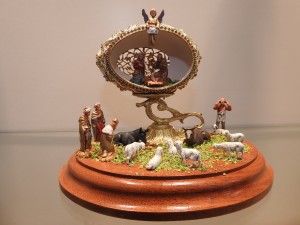 “We are always dreaming of what we are going to do next. We work with all sorts of eggshells, starting with the smallest ones of love-birds and parrots, and moving on to larger ones such as those of pigeons, quails, ducks, geese, emu, rhea and ostrich. The geese’s eggs are the most practical because of their size and shape. Other eggs are relished for their natural particular characteristics such as the blackish colour of the rhea eggs and the large shape and pearly shade of the ostrich eggs.”
“We are always dreaming of what we are going to do next. We work with all sorts of eggshells, starting with the smallest ones of love-birds and parrots, and moving on to larger ones such as those of pigeons, quails, ducks, geese, emu, rhea and ostrich. The geese’s eggs are the most practical because of their size and shape. Other eggs are relished for their natural particular characteristics such as the blackish colour of the rhea eggs and the large shape and pearly shade of the ostrich eggs.”“Christmas brings a lot of joy and memories. This festive season opens up a whole new world to create related items with baby Jesus statues, cribs, angels, Father Christmas, reindeers, sparkles and a whole range of bright colours. We love to reflect the warm meaning of Christmas in our works.”
-
Love is strange doctor
 Choosing a unique white wedding dress, sending out elegant invitations to guests, being led down the aisle by one’s father, shamelessly removing the garter, tossing the colourful bouquet, and giving out souvenirs may be considered as universal marriage traditions. However the reality is far from that. Rituals and customs could vary greatly between cultures, religions and countries, ranging from the sweet and romantic, to the strange and bizarre and at times even to the shocking and outrageous.
Choosing a unique white wedding dress, sending out elegant invitations to guests, being led down the aisle by one’s father, shamelessly removing the garter, tossing the colourful bouquet, and giving out souvenirs may be considered as universal marriage traditions. However the reality is far from that. Rituals and customs could vary greatly between cultures, religions and countries, ranging from the sweet and romantic, to the strange and bizarre and at times even to the shocking and outrageous.Ghost weddings – China
Whereas a wedding is generally expected to be the culmination of a loving and living bride and groom, ghost weddings are still celebrated in some provinces of northern and central China such as Shanxi and Henan. Such weddings are based on a grisly 3000 year old tradition which recommends that the unmarried dead sould not be left alone in the afterlife, otherwise the deceased’s family might get cursed.
Originally this ritual was strictly for the dead and it involved two unmarried dead people. A wedding ceremony was duly celebrated and the two were buried together in the groom’s grave. Mainly aimed for young unmarried men who worked in coal mining and often suffered fatalities, this custom provided the bereaved parents with the opportunity to help their sons find a soulmate and be at peace even after death. It must be said that traditionally, parents felt obliged to assist their sons to settle down in a marriage.
Although this tradition is supposed to have ended, especially with the sale of corpses being outlawed in China in 2006, studies and police reports show that this ritual is more alive than ever. Worse than that, besides being practised secretely, this custom has mutated to a more appalling nature, leading to grave robberies and at times even murders. Prices for female corpses or human remains have increased considerably as parents are ready to carry the financial burden, no matter how difficult it might be.
Fat farms for brides – Mauritania
While many brides go on strict diets to lose weight before the wedding, in rural Mauritania, an attractive bride is a girl with stomach rolls, stretch marks and overlapping thighs. In this society, a thin girl is considered inferior and unappealing and her slim figure will bring shame to her family. An old tradition in this country, known as leblouh, ensures that girls are round and corpulent at their weddings by force feeding them from the tender age of 5.
During the school holidays or in the rainy season, when milk is abundant, girls are sent to ‘fattening farms’ where they are constrained to eat by older women, their aunts or grandmothers. A typical daily intake for a six year old includes two kilos of pounded millet blended with two cups of butter, as well as 20 litres of camel’s milk. Refusal to eat all this food will lead to a subtle form of corporal punishment such as squeezing the girls’ toes between two sticks. Vomit has to be consumed again.
Historians claim that this tradition dates back to pre-colonial times when Mauritania’s population consisted of nomad white Moor Arabs. At the time, a man was deemed wealthy and well respected if his wives could afford to sit still all day and leave the household chores to black slaves. This laziness led these women to gain weight and by time, being overweight became culturally acceptable and regarded as high class.
Even though health campaigners are trying to eradicate this old tradition, the leblouh practice has seen a resurgence in recent years. A successful fattenning process will make a girl of 15 look 30, making it easier for her to get married. Sadly, this custom causes endless illnesses and health problems to these girls in later years.
Cursed wives – India
When searching for a girl to marry, one tends to be attracted by looks or a charming personality. Yet in India, a man has to watch out for more than that since a woman born under Mangal Dosha (a Hindu astrological combination under the influence of planet Mars) is believed to be cursed and after marriage, she might lead to his untimely death.
Such women are known as Mangliks and are looked upon with fear in Hindu society. Their choice of spouse is very limited as they are clearly not regarded as ideal prospective matches in the arranged marriages which take place in this country.
A remedy to break this curse is to marry a clay pot during the kumbh vivah ceremony. This function is just like a real Hindu wedding where the woman has to wear a wedding dress and jewelery along with a thread. A priest is invited to chant the mantra and a marriage celebration takes place between the woman and the pot. Once the wedding is over, the bride will change her clothes, remove the thread and tie it around the pot. Later, when no one is watching, the pot will be drowned in a pond or in a river, thereby releasing the woman from the curse and making her suitable to marry a man.
Spitting on the bride – Kenya
One of the most emotional moments in a wedding is the point when a father accompanies his daughter down the aisle, then removes her veil and kisses her on her cheek before handing her over to her future husband. Yet although similar emotions will be involved during a wedding celebration of the Maasai people in Kenya, the father of the bride will spit on her in order to bless her.
Whereas spitting in many cultures is associated with disgrace and humiliation, in this tribe, this act is regarded to bring good luck and fortune. In fact, Maasai tribesmen will spit on their hands before greeting and shaking hands with elders and it is also customary for them to spit on newborns in order to avert any bad luck.
During a Maasai wedding, the bride’s head is shaved and lamb fat and oil is applied on her head. After her father has spit on her head and breasts, she will leave with her husband and walk away without looking back since she is fearful that she might turn into stone.
(This article was published in The Wedding Supplement issued with The Sunday Times of Malta dated 12th March 2017)
-
Out of its shell
No one can really say what inspired Indrí Dimech known as Il-Mikk in 1898 to start decorating the façade of his property in Għaxaq with hundreds of snails and seashells which he collected from local and foreign beaches. However, some suggest that he might have seen such decorations when he was living abroad.
 Known to be able to do whatever came up to his mind, within two years, Indrí turned the two upper sides of the walls of his property in a huge canvas as he craftly designed them with religious symbols made out of snails and seashells. He embellished this artwork further by adding also three niches, a statue, and some writing which included his surname. Soon this property became renowned as Id-Dar tal-Bebbux (the house of snails).
Known to be able to do whatever came up to his mind, within two years, Indrí turned the two upper sides of the walls of his property in a huge canvas as he craftly designed them with religious symbols made out of snails and seashells. He embellished this artwork further by adding also three niches, a statue, and some writing which included his surname. Soon this property became renowned as Id-Dar tal-Bebbux (the house of snails).More than a century later, much of this unique artistic work has somehow succeeded to withstand the test of time. Yet considerable sections of it have been lost and what remains is in dire need of preservation and restoration. For many years, the Local Council of Għaxaq has been trying to obtain the necessary funds to save this singular property in St Mary Street but no one seems to be interested to protect this national cultural heritage.
“A recent application for funds in a scheme that was dedicated to the restoration of historical sites was disqualified since the work to restore Id-Dar Tal-Bebbux was going to take more than six months. Moreover, we were informed that there were no workers available in the Restoration Section who could do the type of work required for this property,” said Darren Abela, Mayor of the Għaxaq Local Council.
“We were all very disappointed to receive this news. It is deplorable to notice that it is always the same Local Councils who receive the funds to do restoration projects in their localities whilst our locality always ends up with nothing! Although we are in favour of such works, we find it difficult to understand why similar sites obtain the funds to be restored, whereas this property in Għaxaq which is unique, continues to be ignored.”
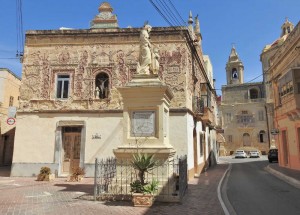 Abela insisted that about fifty years ago, this house was considered to be his village’s jewel while today, it is regarded as the village’s sorrow as it is painful to look at its pitiful state.
Abela insisted that about fifty years ago, this house was considered to be his village’s jewel while today, it is regarded as the village’s sorrow as it is painful to look at its pitiful state.“Everyone who sees this house or who hears about it recommends us to restore its old decorations before we lose them once and for all. And yet, nobody has ever came forward with any solid action to commence these works.”
No estimate of the value of the work required has ever been done because such a project requires particular expertise which till now was not located.
“At the moment, there are three different families living in this property and they have all agreed that this work should be done. I hope it won’t be too late if we’ll ever have the funds to start this project. It is already doubtful whether the snails and seashells which have fallen out could ever be replaced.”
It would definitely be a pity to allow further deterioration of this place. Indeed, Indrì Dimech’s work was deemed significant enough to be included in the National Inventory of the Cultural Property of the Maltese Islands where there is detailed information about the niches and the statues which form part of Id-Dar tal-Bebbux.
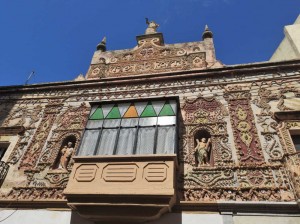 High up on the main facade which bears the date 1901, a small stone statue of the Virgin Mary, the patron saint of Għaxaq, stands triumphantly on a large sphere of clouds. Below it, on the left hand side, one can observe a niche with a stone statue of St Joseph holding baby Jesus; a saint which is also very cherished in this village and for whom a secondary feast is dedicated. On the right, another niche was constructed to contain the stone statue of St Andrew; the saint which has the same name as Indrì. Both these niches have been lavishly decorated with beautiful patterns made with snails and seashells and coloured with paint in between. Only the first three letters of the surname Dimech remain intact on the aperture of the left balcony, the middle balcony displays the letters C. Asciak, whilst the word Malta is still in one piece on the right balcony.
High up on the main facade which bears the date 1901, a small stone statue of the Virgin Mary, the patron saint of Għaxaq, stands triumphantly on a large sphere of clouds. Below it, on the left hand side, one can observe a niche with a stone statue of St Joseph holding baby Jesus; a saint which is also very cherished in this village and for whom a secondary feast is dedicated. On the right, another niche was constructed to contain the stone statue of St Andrew; the saint which has the same name as Indrì. Both these niches have been lavishly decorated with beautiful patterns made with snails and seashells and coloured with paint in between. Only the first three letters of the surname Dimech remain intact on the aperture of the left balcony, the middle balcony displays the letters C. Asciak, whilst the word Malta is still in one piece on the right balcony.Another niche with three stone statues showing a crucified figure of Christ accompanied by the Virgin Mary and St John the Evangelist claims the attention at the center of the other facade. Unfortunately, many of the shells which composed the intricate designs around this niche are now lost.
Several other designs which include religious symbols, particularly those connected to the Passion of the Christ, can also be recognized. A number of other forms show angels, crosses, palm trees, lions, unicorns, fountains, churches, Għaxaq’s coat of arms, and many others.
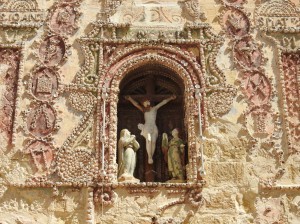 Relatives of Indrì Dimech who often worked as a sailor in the Middle East narrated how he used to return from his voyages carrying numerous shells. Once back home in Għaxaq, he would cover the facade of his property with bedsheets and continue working on his masterpiece. It is not known whether these sheets served as a protection against the sun or whether he intended to surprise his neighbours once he was finished with his work.
Relatives of Indrì Dimech who often worked as a sailor in the Middle East narrated how he used to return from his voyages carrying numerous shells. Once back home in Għaxaq, he would cover the facade of his property with bedsheets and continue working on his masterpiece. It is not known whether these sheets served as a protection against the sun or whether he intended to surprise his neighbours once he was finished with his work.At the time, Indri’s property functioned as a bar wherein men gathered to have a drink and to socialize after a hard day’s work. In there, those who were devoted and passionate about the feast of St Mary met to discuss the events which had to be organized. Meanwhile, this place served also as the hub which sparked the idea of the establishment of the first social club in Għaxaq that was to be dedicated to the titular of the Assumption of Mary.
Even Indrì gave a helping hand to decorate the square that was located in front of his property during the feast. Numerous oil lamps and coloured paper turned the surrounding environment in a surreal atmosphere, especially with his bizarre property in the background.
Today, this property stands in the core of the village, just a few metres away from Għaxaq’s parish church. Although Indrì is gone, his aptitude to mesmerize still lingers on as passers by are captivated by the strange designs that he created. Hopefully, as soon as possible, the authorities would appreciate this gem for its uniqueness and would take the necessary actions to restore back its beauty and allure of bygone days.
(This article was published in the ‘Homes’ Supplement issued with The Sunday Times of Malta dated 3rd April 2016)
-
Guests to history
One would probably spare only a few moments of consideration at the receipt of a wedding invitation. However, for Baron Igino de Piro d’Amico Inguanez, these endearing solicitations were cherished so much that he kept a collection of them, neatly separated according to their date and wrapped up together by a string.
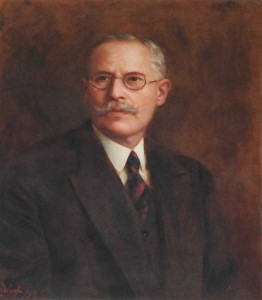 “Were it not for my grandfather’s interest to keep these wedding invitations, we would have lost this fascinating information which can be unravelled within each one of them,” remarked Marquis Nicholas de Piro as we walked towards an elegant table in one of the rooms at Casa Rocca Piccola where he had layed out a number of these invitations.
“Were it not for my grandfather’s interest to keep these wedding invitations, we would have lost this fascinating information which can be unravelled within each one of them,” remarked Marquis Nicholas de Piro as we walked towards an elegant table in one of the rooms at Casa Rocca Piccola where he had layed out a number of these invitations.I glanced out at the wide selection of wedding invitations tastefully set on the polished wooden surface, noticing the different sizes, shapes, writing, designs and paper. The earliest ones dated back to 1815, 1829 and 1832. They were quite plain and small, slightly bigger than a credit card, and written in Italian.
“Here are two of the prettiest ones” said the Marquis as he pulled them out of the rest.
These two invitations had been issued at the end of the 19th century. They were larger than the earlier ones and were quite different from each other. The one dated June 1896 was elegantly designed with an intricate cross at its corner and consisted of an invitation to the wedding between the noble Maria de Piro and Dr. Alfredo Stilon. The other one dated October 1899 was more colourful and rather than an invitation, it was more an announcement of the wedding which was to take place between the noble Maria Teresa de Piro and the Marquis Paolo Apap Bologna. Once again, both were written in Italian.
 “Now look at this note which accompanies this wedding invitation,” said the Marquis as he handed it to me.
“Now look at this note which accompanies this wedding invitation,” said the Marquis as he handed it to me.The presentation of this wedding invitation was simpler than the previous two and the writing was in English. Here, Judge and Mrs L Camilleri were requesting the company of Baron and Baroness I de Piro d’Amico Inguanez and family to the wedding of their noble daughter Inez to Marquis Mallia Tabone on 26th January 1920. Yet this celebration was not destined to take place as a smaller card which was sent some days later informed those invited that this wedding had been indefinitely postponed.
 “From these invitations, one can also observe the traditional customs of the various eras. For example, this wedding invitation dated 1935 shows clearly that people who chose to get married during the period of Lent had to abide to some limitations.”
“From these invitations, one can also observe the traditional customs of the various eras. For example, this wedding invitation dated 1935 shows clearly that people who chose to get married during the period of Lent had to abide to some limitations.”Indeed, a formal note which was inserted together with the wedding invitation that was sent by Chev & Mrs E Moore and Mrs H Xuereb to announce the marriage of their daughter Alice Moore to Godfrey Xuereb, provided this information with direct instructions:
‘It is much regretted that in view of the restrictions imposed by Canon Law for weddings held in Lent, only a few guests may attend the religious ceremony at the Archbishop’s Palace.
You are therefore invited to meet the bride and bridegroom immediately after the ceremony at the residence at 4:00pm.’
 As we followed the different invitations that were sent along the years to Baron Igino and his family, we could also trace some of his friends and acquaintances, their residences, the chapels and churches where the marriages took place, and the selected locations for the wedding receptions. Although many of the churches still exist today, some of the street names had changed from Italian to English or were altered completely. A number of the residences mentioned have become quite renowned today whilst a few others were turned into commercial properties. Sadly, some of the lovely villas which provided exquisite entertainment in the bygone days were demolished to make place for large modern complexes.
As we followed the different invitations that were sent along the years to Baron Igino and his family, we could also trace some of his friends and acquaintances, their residences, the chapels and churches where the marriages took place, and the selected locations for the wedding receptions. Although many of the churches still exist today, some of the street names had changed from Italian to English or were altered completely. A number of the residences mentioned have become quite renowned today whilst a few others were turned into commercial properties. Sadly, some of the lovely villas which provided exquisite entertainment in the bygone days were demolished to make place for large modern complexes. Amongst these, there was the wedding between Hilda Scicluna and Paymaster Lieutenant W Eric Brockman that took place on 4th March 1928. Their marriage was celebrated at the Archbishop’s Palace in Valletta which seems to have been quite a popular venue for such occasions. On the other hand, the reception was held at the bride’s parents residence that was located at 86 Strada Merkanti Valletta; a house which originally belonged to Sir Oliver Starkey, Bali of Aquila and Latin Secretary to Grand Master La Valette. Being an English Knight, he had assisted the Grand Master during the Great Siege of 1565 and was later given the privilege to be buried in the crypt of the Co-Cathedral of St John in Valletta, close to La Valette’s own burial place.
Amongst these, there was the wedding between Hilda Scicluna and Paymaster Lieutenant W Eric Brockman that took place on 4th March 1928. Their marriage was celebrated at the Archbishop’s Palace in Valletta which seems to have been quite a popular venue for such occasions. On the other hand, the reception was held at the bride’s parents residence that was located at 86 Strada Merkanti Valletta; a house which originally belonged to Sir Oliver Starkey, Bali of Aquila and Latin Secretary to Grand Master La Valette. Being an English Knight, he had assisted the Grand Master during the Great Siege of 1565 and was later given the privilege to be buried in the crypt of the Co-Cathedral of St John in Valletta, close to La Valette’s own burial place.The Cathedral in Mdina seems to have been another prominent place for marriages. On 24th January 1937, Adelina Maempel was married to Edwin England Sant Fournier. A reception followed at Villa Luginsland in 26 Boschetto Road, Rabat; a lovely villa which was built by Baron Max von Tucker, the German consul who was serving in Malta in the early 20th century. Unfortunately in recent years years, this remarkable place was in an abandoned state and had a haunting atmosphere.
 The only wedding invitation which came from Gozo looked quite distinguished and it boasted a silver wax seal. The marriage of Carmela and Paul Vella took place on 4th August 1937 and their reception was organized at the Duke of Ediburgh Hotel in Victoria, Gozo. Alas, in recent years, this splendid hotel that was beautifully constructed in Victorian architecture was demolished in order to make way for a commercial centre and a number of residential units.
The only wedding invitation which came from Gozo looked quite distinguished and it boasted a silver wax seal. The marriage of Carmela and Paul Vella took place on 4th August 1937 and their reception was organized at the Duke of Ediburgh Hotel in Victoria, Gozo. Alas, in recent years, this splendid hotel that was beautifully constructed in Victorian architecture was demolished in order to make way for a commercial centre and a number of residential units.“As you have already noted, some of these wedding invitations pertained to our relatives. Incidentally, this one which announces the marriage between my aunt Mona de Piro to Major John E J Nelson on 28th December 1940 is a favourite of mine, particularly because she was quite a character and she kept her high spirits even when she was aged more than ninety. Well, she’s there, looking at us!” the Marquis exclaimed as he pointed to a delightful portrait on the opposite wall.
My eyes met with those of a young, graceful girl, defiantly posing with an off-the-shoulder silver dress which melted in the greyish background behind her.
 “That portrait created much talk when her relatives saw it since it was regarded too sensual at the time. It was commissioned by her Italian boyfriend, Marquis Onofrio Bartolini Salinbeni, and the painting was done by Arthur Acton who lived in a palace in Florence. Onofrio was madly in love with Mona but unfortunately, their relationship ended and when she returned to Malta, a relative of hers went to Italy to claim this painting since it was not deemed fit for him to keep it,” smiled the Marquis as he went to add some logs to the fire burning in the stylish hearth besides us.
“That portrait created much talk when her relatives saw it since it was regarded too sensual at the time. It was commissioned by her Italian boyfriend, Marquis Onofrio Bartolini Salinbeni, and the painting was done by Arthur Acton who lived in a palace in Florence. Onofrio was madly in love with Mona but unfortunately, their relationship ended and when she returned to Malta, a relative of hers went to Italy to claim this painting since it was not deemed fit for him to keep it,” smiled the Marquis as he went to add some logs to the fire burning in the stylish hearth besides us.A warm gush of air embraced the room as the logs protested and cracked and poured a glowing light over the wedding invitations lying in front of us. For a short spell, I thought that I could hear the tinkling of the glasses filled with red velvety wine and golden sizzling champagne as the guests toasted to the newly married couples.
(This article was published in the Weddings Supplement issued with The Sunday Times of Malta dated 13th March 2016)
-
Bats at the museum
As the sun began to set, the sky darkened with the legion of bats which came out of the Rabat catacombs, noted G. Gulia in 1890 in his book Elenco dei Mammiferi Maltesi. Certainly, the tendency of these nightly creatures to live in such dreaded underground areas didn’t help them much in order not to be associated with evil and darkness. Likewise, their strange semblance, their mythical association with Dracula, and images of Satan bearing their wings, hindered even more their reputation. In Aztec and Mayan cultures, bats were deities connected to death. Yet nothing could be far from the truth since bats have a beneficial role in the earth’s ecosystem.
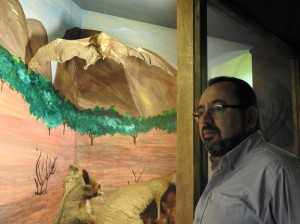 The importance of these unique flying mammals was highlighted during a recent activity which was organized by MEPA’s Environment Division in collaboration with Heritage Malta, at the National Museum of Natural History in Mdina. This annual event, recognized as Malta Bat Night, included a discussion about bats and listening to their sounds through an electronic device.
The importance of these unique flying mammals was highlighted during a recent activity which was organized by MEPA’s Environment Division in collaboration with Heritage Malta, at the National Museum of Natural History in Mdina. This annual event, recognized as Malta Bat Night, included a discussion about bats and listening to their sounds through an electronic device.“Malta Bat Night forms part of a partnership which we have with the European Union for the Research and Conservation of Bats,” explained John Joseph Borg, Senior Curator at the National Museum of Natural History.
“Such events are aimed to inform the public about bats in the hope of removing the negative impression that people have about them. Along the years, bats have decreased considerably in Malta, both because their habitat has often been disturbed, and also due to direct acts of vandalism which were carried out upon them.”
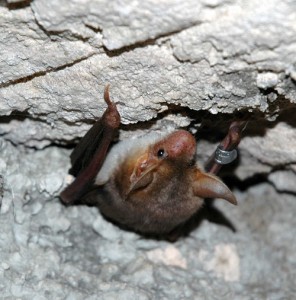 Indeed, Borg explained that colonies of bats have been repeatedly put on fire whilst they were resting in their caves. Others were smothered when vandals threw mud and other things at them, even though they were clearly being protected behind a gate, such as in the case of Ħasan Cave. Bats of a small colony which lived in a site that had access to a particular school, were burnt alive by school children after they captured them and drenched them in hot candle wax.
Indeed, Borg explained that colonies of bats have been repeatedly put on fire whilst they were resting in their caves. Others were smothered when vandals threw mud and other things at them, even though they were clearly being protected behind a gate, such as in the case of Ħasan Cave. Bats of a small colony which lived in a site that had access to a particular school, were burnt alive by school children after they captured them and drenched them in hot candle wax.Well, after hearing these stories, it becomes very clear who the evil ones are.
“Unfortunately our culture has taught us to fear and hate these creatures. In actual fact, their presence could be very advantageous to humans,” revealed Borg.
“Many of the bats eat insects and studies have shown that they tend to feed on species that are harmful to humans and to agriculture. Other small bats which have an elongated snout and a long tongue, act as pollinators when they enter into flower tubes to lick the pollen inside and then move onto different plants. Larger bats, which may look spooky and scary, nurture themselves on decaying fruit and therefore, they keep the fruit trees healthy.”
What about the so called vampire bats. Were they real? And do we have them in Malta?
 “In contrast to peoples’ impression that all bats can suck blood, most of them thrive on insects, fruit, fish and frogs. The only vampire bats which feed on blood are found in South America and they are pretty small. They are nothing similar to the fictional bats that we see in films. In fact, they do not suck blood but they lick it, thanks to their anticogulant saliva which prevents the blood from clotting. They do not normally attack human beings and neither animals. However, they will feed on any animal available if it is reachable to them, including humans.”
“In contrast to peoples’ impression that all bats can suck blood, most of them thrive on insects, fruit, fish and frogs. The only vampire bats which feed on blood are found in South America and they are pretty small. They are nothing similar to the fictional bats that we see in films. In fact, they do not suck blood but they lick it, thanks to their anticogulant saliva which prevents the blood from clotting. They do not normally attack human beings and neither animals. However, they will feed on any animal available if it is reachable to them, including humans.”Borg informed me that we have seven resident species of bats which are: Lesser Horse-shoe Bat (Rhinolophus hipposideros), Maghrebian Bat (Myotis punicus), Grey Long-eared Bat (Plecotus austriacus), Savi`s Pipistrelle (Hypsugo savii), Kuhl`s Pipistrelle (Pipistrellus kuhlii), Common Pipistrelle (Pipistrellus pipistrellus), and Soprano Pipistrelle (Pipistrellus pygmaeus).
 “We have bats from all these resident species living in this museum,” smiled Borg who has an avid passion about bats. “In the underground tunnels there are the Lesser Horse-shoe and the Maghrebian Bats, whereas in the rooms of the underlying level, one finds the Grey Long-eared and the Lesser Horse-shoe Bats. Moreover, all the four Pipistrelle species have managed to make a home in some cracks of the facade and on the high beams.”
“We have bats from all these resident species living in this museum,” smiled Borg who has an avid passion about bats. “In the underground tunnels there are the Lesser Horse-shoe and the Maghrebian Bats, whereas in the rooms of the underlying level, one finds the Grey Long-eared and the Lesser Horse-shoe Bats. Moreover, all the four Pipistrelle species have managed to make a home in some cracks of the facade and on the high beams.”From the remains of moth wings which Borg collects from the museum floor early in the morning for his studies, he is able to identify more information about his resident bats, such as what they prey on. Interestingly, each small Pipistrelle is able to eat around 20,000 moth each night, thereby being more effective than the insect sprays which we use. Nonetheless, most people have no idea about this and when they realize that they are co-habitating with bats, hell breaks lose.
“We do receive calls from people who request us to remove bats from their properties. It is very rare that these creatures enter into homes. Usually they live in cracks in external windows or in narrow openings in facades. Some of the bats are minute in size and in fact, five of them can be placed in a matchstick box. Generally, once these people realize that these animals will be doing no harm to them or to their family, they will agree to allow them to stay. Yet there were cases when the individuals concerned were adamant that they wanted them removed.”
 In such cases, Borg or other responsible officials will need to go and survey the bats before taking action. This involves counting them daily for a whole week in order to confirm the exact amount of bats that are roosting in this place. Once, this amount is identified, they will wait until all the bats are out at night and then they will block the nest in order not to let them in again. Eventually, when the bats will return home and realize what happenned, they will automatically move away to a second area which they tend to keep as a form of protection.
In such cases, Borg or other responsible officials will need to go and survey the bats before taking action. This involves counting them daily for a whole week in order to confirm the exact amount of bats that are roosting in this place. Once, this amount is identified, they will wait until all the bats are out at night and then they will block the nest in order not to let them in again. Eventually, when the bats will return home and realize what happenned, they will automatically move away to a second area which they tend to keep as a form of protection.“This procedure to count bats is very important because they do not always leave the nest in the same number. Usually, a scout bat will fly out first in order to check whether it is windy and whether there are enough insects available in the area. If he returns, the others will stay inside but if he does not, they will understand that the situation is favourable and they will fly out too.”
I couldn’t help feeling impressed by these creatures. Yet more was still to come.
 “The courting and copulation of bats takes place in autumn, between October and November. Then, as soon as the temperature drops and insects are more rare, they will fall in a state of torpidity which is a short period of sleep. During this time, the sperm with which the female has been fertilized will remain stored inside her, waiting for the right moment to come. Once the tempertaure gets warmer and insects become available, these bats will wake up and the real preganancy will start. In this way, both the mother and the offspring will have a better chance to survive.”
“The courting and copulation of bats takes place in autumn, between October and November. Then, as soon as the temperature drops and insects are more rare, they will fall in a state of torpidity which is a short period of sleep. During this time, the sperm with which the female has been fertilized will remain stored inside her, waiting for the right moment to come. Once the tempertaure gets warmer and insects become available, these bats will wake up and the real preganancy will start. In this way, both the mother and the offspring will have a better chance to survive.”Although there are some who associate bats with flying mice, Borg informed me that there is nothing common between the two. While mice come from the order Rodentia, bats form part of the order of Chiroptera (meaning hand-wing).
 “The oldest bat fossils date back to 55 million years ago where this mammal had already the shape which we know today. On the other hand, the oldest fossils which were found in Malta go back to the Ice Age at around 200,000 and 10,000 years ago. These were found during excavations at Għar Dalam and so we can say that these ancient bats remember the dwarf elephants and hippopotami roaming around. At this museum, we do hold a sample of these fossils. However, the majority of them were taken by the foreign researchers who were doing the excavations, and these passed on their discoveries to their relative museums.”
“The oldest bat fossils date back to 55 million years ago where this mammal had already the shape which we know today. On the other hand, the oldest fossils which were found in Malta go back to the Ice Age at around 200,000 and 10,000 years ago. These were found during excavations at Għar Dalam and so we can say that these ancient bats remember the dwarf elephants and hippopotami roaming around. At this museum, we do hold a sample of these fossils. However, the majority of them were taken by the foreign researchers who were doing the excavations, and these passed on their discoveries to their relative museums.”In the Mdina museum, one can also find some current bat specimens. Borg insisted that it is not the policy of the museum to capture and kill creatures in order to preserve them. So, one won’t find a specimen for each species which live in Malta. Nevertheless, the museum will do his best to assist whoever will request information about bats.
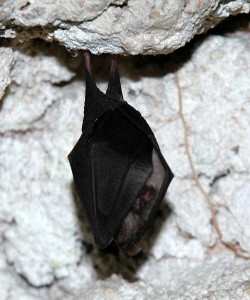 Borg’s own interest in bats goes back to the 1980s. Originally fearful of them, he came face to face with these bats whilst he was doing bird studies and these nightly creatures were being captured accidentally in nets. At first nervous, he asked others to remove them for him, until one day, he decided to do the job himself.
Borg’s own interest in bats goes back to the 1980s. Originally fearful of them, he came face to face with these bats whilst he was doing bird studies and these nightly creatures were being captured accidentally in nets. At first nervous, he asked others to remove them for him, until one day, he decided to do the job himself.From then on, he was completely captivated by them and has been studying them ever since, eager to share his knowledge in the hope of fostering more interest from the public.
It is safe to say that Malta Bat Night has certainly gone a long way towards achieving this.
(This article was published in Escape Suppliment issued with the Sunday Times of Malta dated 29th November 2015)
-
A HIDDEN BEAUTY SPOT
In contrast to the city of Beijing, wherein we visited some of the most splendid sites of Chinese historical significance, Shanghai seemed bound to impress us with its ultra modern, cosmopolitan character and its new high rises. Even though we were informed that a number of old structures in Shanghai were being preserved in order to conserve the roots of this area, our initial general impression was that the new buildings had taken over considerably its Chinese origins.
 Therefore, it was quite a pleasant surprise to learn that tucked safely away at relatively short distances from this avant-garde city, one could still find a wide selection of ancient water towns which offer the opportunity to relish the charm of an ancient China. Known as the ‘Little Venices of the East’, these unique towns of exceptional allure are a wonder of cultural landscape. A visit to at least one of them, is definitely a must once you are in Shanghai.
Therefore, it was quite a pleasant surprise to learn that tucked safely away at relatively short distances from this avant-garde city, one could still find a wide selection of ancient water towns which offer the opportunity to relish the charm of an ancient China. Known as the ‘Little Venices of the East’, these unique towns of exceptional allure are a wonder of cultural landscape. A visit to at least one of them, is definitely a must once you are in Shanghai.Since we had only one day left in Shanghai, our guide led us to Zhujiajiao which is located only forty seven kilometers away from this city, in the district of Qingpu. With a history of around 1700 years, Zhujiajiao is renowned as one of the best preserved ancient water towns of the area. Like much of the other sites in China, once we got there, we found the place pretty crowded, especially since on that day, the local people were celebrating the Mid-Autumn Festival. Indeed, during public holidays, these water towns are very popular with Shanghai residents who yearn for moments of tranquility, away from the hustle and bustle of the urban areas.
 The settlement of Zhujiajiao dates back to the Yuan dynasty, when this location was turned into an important trading hub for the surrounding countryside. Since it is strategically situated at the intersection of a number of local rivers, Zhujiajiao continued to gain significance, and during the reign of Emperor Wanli of the Ming dynasty, it was granted township status. The town prospered by trading rice and cloth which were transported on boats from the surrounding countryside, right to the houses of the Zhujiajiao merchants.
The settlement of Zhujiajiao dates back to the Yuan dynasty, when this location was turned into an important trading hub for the surrounding countryside. Since it is strategically situated at the intersection of a number of local rivers, Zhujiajiao continued to gain significance, and during the reign of Emperor Wanli of the Ming dynasty, it was granted township status. The town prospered by trading rice and cloth which were transported on boats from the surrounding countryside, right to the houses of the Zhujiajiao merchants.Today, this town which covers about 3 square kilometers, has a population of about 70,000 people. Although nowadays, one finds some recent and modern structures in Zhujiajiao, about a thousand of the surviving buildings and ancient markets were constructed during the Ming and Qing dynasties.
 Thirty six bridges of different sizes, designs, and materials, cross the small rivers shaded by willow trees, and connect the ancient town. Whilst the narrowest bridges are only about a metre wide, Zhujiajiao can boast to have the largest stone arch bridge in Shanghai. Originally built in 1571 by the monk Xingchao of Cimen Temple in 1571, and then rebuilt in 1812, Fangsheng Bridge rests on five arches and is 70 metres long, and 5.8 metres high. The central arch is decorated with a stone relief of eight dragons surrounding a pearl, whilst the pillars at the ends are sculpted into lions.
Thirty six bridges of different sizes, designs, and materials, cross the small rivers shaded by willow trees, and connect the ancient town. Whilst the narrowest bridges are only about a metre wide, Zhujiajiao can boast to have the largest stone arch bridge in Shanghai. Originally built in 1571 by the monk Xingchao of Cimen Temple in 1571, and then rebuilt in 1812, Fangsheng Bridge rests on five arches and is 70 metres long, and 5.8 metres high. The central arch is decorated with a stone relief of eight dragons surrounding a pearl, whilst the pillars at the ends are sculpted into lions.Interestingly, ancient bridges can be recognized from more recent ones by looking at the height of their stairs, since in the old days, these were quite steep, whereas nowadays, steps are constructed in lower and more uniform positions, in order to be more easily accessible, especially to the elderly.
 Both these bridges and the town itself can be appreciated further by taking a cruise on one of the small bamboo gondolas that navigate the countless waterways of Zhujiajiao. A short trip and a longer one are offered, wherein the first takes passengers up and down the main canal, whilst the latter travels all over the town and back.
Both these bridges and the town itself can be appreciated further by taking a cruise on one of the small bamboo gondolas that navigate the countless waterways of Zhujiajiao. A short trip and a longer one are offered, wherein the first takes passengers up and down the main canal, whilst the latter travels all over the town and back.In order to explore this town, one needs about four hours. Narrow streets filled with different shops that sell typical souvenirs and various other products are often packed with tourists who tend to disrupt the serenity that one would have expected to find in such a location. The one kilometre North Streetis the best preserved ancient street in this suburb where one can observe the historical architecture. On the other hand, in Xijin Street, one can visit the classical Kezhi Garden with its distinguished combination of traditional Chinese and Western styles.
 A closer investigation of Zhujiajiao can offer much more to see, includingTongtianhe Medicine Shop, Qing Dynasty Post Office, Baoguo Temple, and Yuanjin Meditation Room. A selection of bars, restaurants, teahouses, and coffee shops provide the opportunity to rest and to taste some local cuisine whilst gazing out at the rivers or the main canal.
A closer investigation of Zhujiajiao can offer much more to see, includingTongtianhe Medicine Shop, Qing Dynasty Post Office, Baoguo Temple, and Yuanjin Meditation Room. A selection of bars, restaurants, teahouses, and coffee shops provide the opportunity to rest and to taste some local cuisine whilst gazing out at the rivers or the main canal.Having gone through a period of inactivity, where life crawled on at a slow pace, in these last years Zhujiajiao has gone through a rapid transformation as both locals and foreigners began to long for such preserved gems which can relate strongly to a bygone period in China.
Although some believe that the heavily touristic element on which the inhabitants have become highly dependent, is ruining the romantic nature of this sublime ancient water town, I can say that I enjoyed every minute which I spent in this exotic place. A heaven for photographers, Zhujiajiao provides an unforgettable experience of a surreal Chinese life which has succeeded to endure the test of time.
(This article was published in ESCAPE Suppliment which was issued with the Sunday Times of Malta dated 1st November 2015)
-
AROUND THE WORLD IN 90 DAYS
“They say that you always travel three times: the first time when you are planning your holiday,then when you actually travel, and finally when you watch the photos that you have taken whilst travelling,” Jennifer told me as she proudly showed me the pictures that she and her husband Alan took during their three month honeymoon trip around the globe.
Since Alan Borg and Jennifer Cusba got to know each other, their life turned into an adventure. They met incidentally on a boat trip whilst they were visiting the enchanting lakeside town of Guatapé in Colombia.
 “I was on holiday in Colombia with my friends, when we decided to go on this particular boat trip. At one point, I saw Jennifer walking by with her mother and I liked her immediately. So I followed her, waiting for an excuse to talk to her. The right moment came when I noticed that she needed someone to take their photo and I offered to help. Then, I made sure to take a photo with her too,” revealed Alan.
“I was on holiday in Colombia with my friends, when we decided to go on this particular boat trip. At one point, I saw Jennifer walking by with her mother and I liked her immediately. So I followed her, waiting for an excuse to talk to her. The right moment came when I noticed that she needed someone to take their photo and I offered to help. Then, I made sure to take a photo with her too,” revealed Alan.For the following three months, they kept in contact through Facebook. During one of their communications, Jennifer who is Colombian, told Alan that she was planning to go to America to study English.
“I lived in Bogotá, the capital city of Colombia, where I worked as an internal auditor of a governmental company. I had studied hard to obtain this job and in the first years, I was very satisfied that I had succeeded in this career. However, as time went by, I felt that life had become stale. I woke early each day to travel for two hours to reach work, meeting always the same people on the bus and at work, and likewise on my two hour ride back home. At 29 years, I felt as if I was stuck in a rut and I was afraid that if I continued to live this mundane life, I would lose all the essence of life. I definitely had to do something to make a change,” reminisced Jennifer.
Once again, Alan did not fail to grab the opportunity, and as soon as he learnt that Jennifer wanted to study English, he informed her about the selection of English schools that there were in Malta. Attracted by Alan’s gentle and friendly attitude, and also by the fact that it was cheaper to study in Malta than in America, Jennifer chose the small archipelago of the Maltese Islands. Once in Malta, their friendship grew stronger, she gave up her job in Colombia, and a year later, they got married.
 “When we told our friends and relatives that we were going to get married, they all wanted to know when and where the wedding is going to take place and how many guests would be invited. However, we had no intention of spending thousands of euros for just a few hours of enjoyment. Our plans were much bigger!” claimed Alan.
“When we told our friends and relatives that we were going to get married, they all wanted to know when and where the wedding is going to take place and how many guests would be invited. However, we had no intention of spending thousands of euros for just a few hours of enjoyment. Our plans were much bigger!” claimed Alan.“On our wedding day we were joined by our family and closest friends. After the celebration, we shared a cake, drank some champagne, took photos, had a lot of fun, and that was that. The big moment came seven months later, when we prepared our backpacks and left for the adventure of a lifetime,” continued Jennifer.
Alan decided to make the best of the various offers and discounts that his job with an airline company afforded him. The couple started out with an initial idea of a simple honeymoon to Santorini, fully aware that they’d need to get a connecting flight from another location. Soon, this stopover was joined by other countries until the list grew and grew. Eventually, they decided to go on a three month trip around the world, to the total tune of 15,000 euros.
 “We both love to travel. Yet I was the one who was more experienced in travelling to faraway countries without concerning myself too much on a fixed itinerary. In fact, at first, Jennifer was somehow incredulous whether this voyage would take place for real,” smiled Alan.
“We both love to travel. Yet I was the one who was more experienced in travelling to faraway countries without concerning myself too much on a fixed itinerary. In fact, at first, Jennifer was somehow incredulous whether this voyage would take place for real,” smiled Alan.“It’s true! I was worried whether we would have enough money to do it all and what would happen if we spent everything whilst still abroad? I was also afraid that someone could steal our cards or that unknowingly, we could end up in some dangerous country or get caught up in a terrorist attack.”
In reality, during this amazing voyage, the couple did have their fare share of risk… In New York, they experienced a huge storm and they could not get out of their hotel room. In Colombia, whilst they were seeing a horseshow, an earthquake shook the building which they were in. In Australia, just a week after they left, the Central Coast was a complete disaster with houses being carried away due to heavy floods and strong winds.
“Before we left on our adventure, I left a simple message on Facebook saying that we were going on our honeymoon, never mentioning that we were going for a trip around the world, because I couldn’t believe it myself! Off we went to Amsterdam and then we started to move and move and move, until I realized that this dream was becoming true. It became very very real whilst we were on the long flight crossing from Australia to Japan, and I started to note the various countries showing on the screen in front of me. By then, we had been to many of them, changing even continents, and there it dawned on me that we were truly going around the world,” Jennifer exclaimed.
 Although they had planned an overall general itinerary of the places and sites which they wished to visit, they prebooked nothing except their first destination to Amsterdam. And yet, they managed to see and do many many things. Their travels took them to Amsterdam, New York, Las Vegas, Arizona, San Francisco, Mexico, Brazil, Colombia, Peru, Chile, Sydney, New South Wales, Melbourne, Queensland, Japan, and Istanbul.
Although they had planned an overall general itinerary of the places and sites which they wished to visit, they prebooked nothing except their first destination to Amsterdam. And yet, they managed to see and do many many things. Their travels took them to Amsterdam, New York, Las Vegas, Arizona, San Francisco, Mexico, Brazil, Colombia, Peru, Chile, Sydney, New South Wales, Melbourne, Queensland, Japan, and Istanbul.“Ultimately, this was not just a holiday but an experience. Certainly, quite a great way to start a new and exciting chapter as husband and wife,” beamed Alan as he winked at Jennifer.
(This article was published in ‘Escape’ cultural suppliment issued with the Sunday Times of Malta dated 4 October 2015)
-
Unlocking the Great Wall’s stories
‘He who has not climbed the Great Wall is not a true man’ declares a Chinese saying.
After being confronted by the challenging steps of this legenday wall, I must admit that I understand fully the meaning behind this expression.
Constructing the Great Wall of China
 The Great Wall consists of a massive series of fortifications which extend over five thousand kilometres from east to west in north China. Since it outstretches over a number of provinces, one can visit its diverse sections from various locations. Its construction took around two thousand years and it involved the input of several dynasties which were ruling the country during different period.
The Great Wall consists of a massive series of fortifications which extend over five thousand kilometres from east to west in north China. Since it outstretches over a number of provinces, one can visit its diverse sections from various locations. Its construction took around two thousand years and it involved the input of several dynasties which were ruling the country during different period.Since for many years, various Chinese states were at war against each other, by the 7th century BC, the locals had already mastered an excellent skill in the building of protective walls with which to defend their villages. It was from this period that construction of the Great Wall commenced.
In 221 BC, Qin Shi Huang succeeded to win over all his opponents. He unified China for the first time, established the Qin Dynasty, and became the first Emperor. To impose a centralization of authority, he ordered the destruction of various defensive walls which had been built around the country by different feudal lords. Instead, he constructed new walls which connected a number of fortifications that were situated in the northern side of his empire. These were intended to shield his people and his country from the opponent nomadic tribe Xiongnu which resided in this area (today known as Mongolia).
It was no easy feat to construct these walls in the chosen locations which winded throughout valleys or climbed across mountains. At the time, no machinery was available to facilitate this grueling work. Yet, the Chinese managed to erect these walls by utilizing the material that was available in each particular zone and by working according to the contours of the terrain.
No one knows how many people worked or died during the construction of this wall. Many insist that the total number could easily reach millions. Certainly, their effort led to the creation of a unique masterpiece which today is regarded as one of the seven wonders of the ancient world. In 1987, the Great Wall of China became also part of the UNESCO World Heritage List.
A popular legend
 This wall is imbued with many narratives and legends. Yet the most popular is surely that of Meng Jiang Nü; a young woman who is believed to have lived during the 3rd century BC, in the Qin Dynasty.
This wall is imbued with many narratives and legends. Yet the most popular is surely that of Meng Jiang Nü; a young woman who is believed to have lived during the 3rd century BC, in the Qin Dynasty.Her story recounts that one day, Fan Qi Liang, a young man who had been engaged to work on the Great Wall, succeeded to escape from this strenuous job. He ran with all his might along the way until at one point, he was so exhausted that he stopped to hide in the garden of Meng’s father.
The two fell in love immediately as soon as their eyes met, and some time after, they got married. Yet unfortunately, their happinness did not last long as the man was located by soldiers and he was taken back to work on the wall.
The woman waited and waited for her husband’s return. But when winter was close and he still did not come back, she sewed some warm clothes for him in order to protect him from the cold. She went in search of him at his work place but after she looked out for him wherever she could and inquired about him, she was finally informed that her husband had died and that he had been buried within the wall itself.
This tragic news shattered the woman’s spirit and she was so griefed that she spent a whole day and a whole night weeping beneath the wall. Her desperation ran so deep that suddenly, the wall in front of her crumbled and a number of corpses slid out of it.
Shocked at this gruesome scene, Meng Jiang Nü cut her finger and she allowed her blood to trickle on the corpses. At one point, she noticed that all her blood ran to a particular corpse and it was then that she recognized her husband’s body. She gathered him lovingly and gave him a decent burial. Then, she walked to a river and ended her life within.
Juyongguan Pass – Beijing
 I had read and heard so much about the greatness of this wall that when I arrived at one of its sections in Beijing, known as Juyongguan Pass, I simply stood in silence and in awe.
I had read and heard so much about the greatness of this wall that when I arrived at one of its sections in Beijing, known as Juyongguan Pass, I simply stood in silence and in awe.My eyes ran afar, up into the sky where a thick fog was hiding the highest part that was visible from the ground. Located at around fifty kilometres away from Beijing, this part of the wall is about 4000 metre long and is situated amongst the mountains of Changping District.
This pass has always been renowned for its strategic significance and its impenetrability. Notwithstanding this, in 1644, a group of rebellious farmers led by Li Zicheng, managed to enter into Beijing by overcoming this area. It is said that this happenned not because of any weakness in the wall but due the fact that the local people were too impoverished to resist.
Today, Juyongguan Pass is distinguished for its lovely scenic views of the surrounding forests, particularly since these change their colours according to season.
Experiencing the magic of the Great Wall
We arrived at nine in the morning in order to avoid the crowds but there were already many visitors climbing the wall. The weather was not very welcoming as it was drizzling and the fog made it difficult to take very good photos. Yet nothing could stop us from climbing that legendary wall which we had all dreamt so much about!
 Up we went the first steps but soon we realized that it was not going to be that easy to climb too far. For the Great Wall’s steps were constructed in differing heights in order to make it difficult for the enemy to run up and make a surprise attack. Whilst some of the steps were low, others were quite high and after a short time, if you’re not the sporty kind, you’ll definitely find yourself out of breath.
Up we went the first steps but soon we realized that it was not going to be that easy to climb too far. For the Great Wall’s steps were constructed in differing heights in order to make it difficult for the enemy to run up and make a surprise attack. Whilst some of the steps were low, others were quite high and after a short time, if you’re not the sporty kind, you’ll definitely find yourself out of breath.Step after step, we arrived at the first tower which consisted of a number of small rooms. I decided to check out a set of narrow stairs which led to the tower’s roof and from there, the overview of the open landscape was even more splendid. I looked around in a blending state of rapture, wonder and disbelief as I imagined that this could have been the same view that the legendary soldiers watched over. For a moment, time seemed to stop and the present melted into the past as I simply stood there holding on to the ancient stones.
I could have stayed there to absorb within me all the history of the place but the group needed to move on and so, we climbed further. Over all, the set up of the wall repeats itself as its length is divided into steps and a number of towers. Yet I can say that I would have continued to climb all day if we did not have planned to visit other sites.
Going down the steps was relatively easy but by then, the place had become quite crowded with people of all nationalities who came to visit.
A love bound to eternity
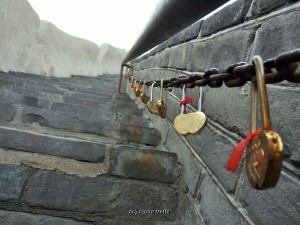 As I stole a last glance at this architectural and historic marvel, I noticed a quantity of lovelocks that were fastened to chains running along the Great Wall. On a closer look, I found out that these were decorated with heart designs and the names of couples were engraved on each of them. Our guide told us that those lovelocks formed part of an old Chinese tradition which stated that if a couple wrote their names on a lock and closed it on this chain, their love would be eternal, just like the destiny of this mythical wall.
As I stole a last glance at this architectural and historic marvel, I noticed a quantity of lovelocks that were fastened to chains running along the Great Wall. On a closer look, I found out that these were decorated with heart designs and the names of couples were engraved on each of them. Our guide told us that those lovelocks formed part of an old Chinese tradition which stated that if a couple wrote their names on a lock and closed it on this chain, their love would be eternal, just like the destiny of this mythical wall.(This article was published in the Travel Supplement of the Sunday Times of Malta dated 21st June 2015)
-
Discovering the real art of a new culture
China’s art sector is probably one of the most dynamic today since Chinese artists are constantly re-imagining the boundaries of art as they question their country’s role in the world. These artistic works can be viewed in the several popular art districts, key galleries and museums which are located in various areas around China.
751D Park – Beijing
I had thought that a visit to Beijing would only comprise an itinerary to historical sites. Therefore, this bustling contemporary art centre proved to be quite a surprise.
Having been transformed from an industrial plant into an artistic hub, 751D Park boasts an area of 40,000 square meters and is now a very renowned area for art lovers. Its distinguished Bauhaus-style architecture has succeeded to blend harmoniously with the places’s new character which now houses many art galleries, bookshops, cafes and restaurants.
Although I am not an avid art enthusiast, a stroll around the various shops and art exhibitions of this park served as a portal to another facet of China and its culture. Each outlet provided the opportunity to discover and purchase works of unique styles, original designs and ultimate creativity.
 I was particularly captivated by Liu Fei’s artistic exhibition named ‘An Enchanting War’. The artist described his sharp creations as his contemplation of future wars. Through them, he attempted to engage in social and political life in order to express his distaste and criticism on war. His main theme examined whether future warfare would be a performance of pretences? In his strong and bizarre artworks, there was no boundary between beauty and ugliness, and violence and contention were combined cruelly.
I was particularly captivated by Liu Fei’s artistic exhibition named ‘An Enchanting War’. The artist described his sharp creations as his contemplation of future wars. Through them, he attempted to engage in social and political life in order to express his distaste and criticism on war. His main theme examined whether future warfare would be a performance of pretences? In his strong and bizarre artworks, there was no boundary between beauty and ugliness, and violence and contention were combined cruelly.The National Art Museum of China – Beijing
The National Art Museum of China is dedicated to collection, research and exhibitions of modern and contemporary artistic works in China. Although this structure started to be constructed in 1958 and was open to the public in 1963, its architecture features the traditional Chinese style as the main building is roofed with yellow glazed tiles and surrounded by corridors and pavilions.
This museum covers an area of more than 18,000 square meters and it includes 17 exhibition halls throughout its 5 storeys. It prides itself with more than 100,000 pieces of various collections, most of which are representative works of different periods and great artworks of Chinese art masters from the end of the 19th century till today.
 Since its establishment, this national museum has organized thousands of various artistic exhibitions which reflect the development of Chinese art. These activities have attracted millions of visitors each year and so this museum has also served as a significant platform for the artists involved.
Since its establishment, this national museum has organized thousands of various artistic exhibitions which reflect the development of Chinese art. These activities have attracted millions of visitors each year and so this museum has also served as a significant platform for the artists involved.During my visit, amongs its selection of expositions, this museum was holding the exhibition ‘Beautiful China: Call of Humanism’ which entailed the First National Fine Art Exhibition to help the disabled. The ensemble of 200 pieces of artworks included masterpieces of top artists of the contemporary art world,as well as works of disabled calligraphers and painters. Funds from the sales of these artworks were collected in order to assist the needs of the thousands of disabled Chinese individuals.
M50 – Shanghai
50 Moganshan Road or M50 art district as it is more popularly known, was a former textile mill in central Shanghai which has now been converted into a major zone of artistic galleries and exhibition spaces.
This quarter started to become popular with artists in the year 2000 when the first individuals were initially attracted by the cheap rent of the disused industrial space. Soon, other artists followed suit and nowadays this complex has become known for its trendy and high art quality.
 Art lovers who visit this place get a chance to enjoy and purchase some fantastic and unusual works directly from the artists themselves. The allure of this zone lies in the variety of displayed works using several mediums.Prices range from affordable to really expensive but one is expected to negotiate.
Art lovers who visit this place get a chance to enjoy and purchase some fantastic and unusual works directly from the artists themselves. The allure of this zone lies in the variety of displayed works using several mediums.Prices range from affordable to really expensive but one is expected to negotiate.Popular with both local and international visitors, this art quarter is unpretentious but interesting and often thought provoking. Amongst the wide selection of creations, it is engaging to notice also some works of a rebellious nature.
(This article was published in the Travel, Leisure and Food Supplement in the Sunday Times of Malta dated 15 March 2015)
Travelogue
Archives
| M | T | W | T | F | S | S |
|---|---|---|---|---|---|---|
| « Jan | ||||||
| 1 | 2 | 3 | 4 | 5 | 6 | 7 |
| 8 | 9 | 10 | 11 | 12 | 13 | 14 |
| 15 | 16 | 17 | 18 | 19 | 20 | 21 |
| 22 | 23 | 24 | 25 | 26 | 27 | 28 |
| 29 | 30 | 31 | ||||
Recent Posts
- A MATTER OF FATE
- MALTA’S PREHISTORIC TREASURES
- THE MAGIC IS IN THE DETAIL
- THE SELLING GAME
- NEVER FORGOTTEN
- Ġrajjiet mhux mitmuma – 35 sena mit-Traġedja tal-Patrol Boat C23
- AN UNEXPECTED VISIT
- THE SISTERS OF THE CRIB
Comments
- Pauline Harkins on Novella – Li kieku stajt!
- admin on IL-KARNIVAL TRAĠIKU TAL-1823
- Albert on IL-KARNIVAL TRAĠIKU TAL-1823
- Martin Ratcliffe on Love in the time of war
- admin on 24 SENA ILU: IT-TRAĠEDJA TAL-PATROL BOAT C23